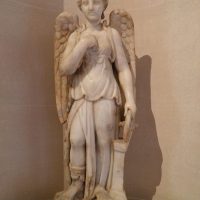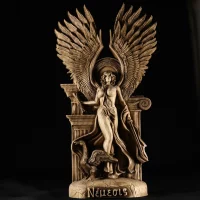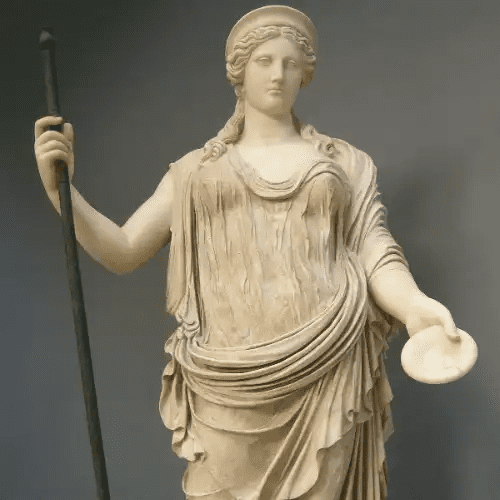Nemesis : Goddess of Retribution
Listen
At a glance
| Description | |
|---|---|
| Origin | Greek Mythology |
| Classification | Gods |
| Family Members | Oceanus (Father) |
| Region | Greece |
| Associated With | Balance, Retribution |
Nemesis
Introduction
Nemesis, a central figure in Greek religion, embodies the concept of divine retribution, particularly targeting those who display hubris, or arrogance before the gods. She personifies the resentment felt by mortals towards those who evade justice or enjoy excessive good fortune. Within the vast array of Greek mythology, Nemesis holds a distinct position as the goddess of retribution, emphasizing the consequences of one’s deeds, whether virtuous or malevolent. Unlike the Olympian gods who govern specific realms, Nemesis symbolizes abstract principles, serving as the unwavering force of divine justice. Her domain encompasses revenge, justice, and the restoration of balance, ensuring that neither arrogance nor adversity disrupts the cosmic equilibrium.
Physical Traits
Nemesis is commonly depicted with an air of solemnity, appearing as a formidable figure exuding authority and impartiality. Her austere countenance reflects a resolute demeanor, with penetrating eyes that seem to discern the very essence of those who challenge the natural order. Adorned in regal attire suitable for her divine status, she commands respect and demands recognition of one’s deeds without evoking fear. Often depicted as a winged goddess, Nemesis is associated with various symbols such as a whip, dagger, scales, and a wheel, each representing facets of fate and justice. While ancient Greek art featuring Nemesis is relatively scarce, existing representations frequently portray her with wings, symbolizing her swift delivery of retribution. Accompanied by a whip, she symbolizes punishment for the arrogant and unjust, while the presence of scales underscores the impartial assessment of actions and their consequences.
Family
Nemesis’s origins remain veiled in mystery, with conflicting accounts regarding her parentage. Hesiod, an early Greek poet, ascribes her lineage to Oceanus and Gaia, primordial deities predating the Olympian gods, positioning her amidst the ancient cosmic powers. However, alternate narratives propose Erebus and Nyx as her parents, highlighting her affiliation with fundamental aspects of existence. While Hesiod’s Theogony identifies Oceanus as her father, other sources suggest Nyx as her mother, omitting mention of a father figure. Additionally, Nemesis is occasionally portrayed as the mother of Helen of Troy, sired by Zeus in the guise of a swan, catalyzing the events leading to the Trojan War. In the intricate tapestry of Greek mythology, Nemesis emerges as a progeny of Nyx, the primordial goddess of night, though her lineage varies across accounts, with Erebus also posited as her progenitor. Despite these disparities, Nemesis’s connection to the foundational forces governing the cosmos underscores her pivotal role in upholding equilibrium.
Other names
Throughout mythology, Nemesis assumes various epithets that capture her multifaceted essence. Among these, Adrasteia stands out, symbolizing the inevitability of fate, while Rhamnousia associates her with the revered sanctuary of Rhamnous. These alternative names offer insights into different dimensions of Nemesis’s character, enriching her mythological significance. Additionally, Nemesis is known by several other titles such as Adrasteia, emphasizing her inescapable nature, and Rhamnousia, derived from the city where she received veneration. These diverse appellations reflect the complexity of Nemesis’s persona, each shedding light on distinct aspects of her divine presence.
Powers and Abilities
Nemesis possessed the power to bring both joy and suffering to humanity, maintaining a delicate equilibrium in their lives. Associated with the wheel, she could grant fortune or strip it away, altering individuals’ destinies as a form of reward or punishment. Central to her role was the enforcement of cosmic balance, empowered by formidable abilities. Nemesis wielded the feared capability to exact vengeance upon those who exceeded their bounds or enjoyed undue prosperity. This retribution, ranging from personal misfortunes to public shame, served as a powerful deterrent.
Gifted with a keen sense of justice, Nemesis could differentiate between genuine merit and unwarranted arrogance. This discernment enabled her to target deserving individuals for punishment. Once Nemesis selected a transgressor, evasion proved futile. Her relentless pursuit ensured swift and unavoidable consequences for wrongdoing. While Tyche dispensed random fortune, Nemesis countered by ensuring repercussions for excessive blessings. As the ultimate arbiter of justice, her powers transcended mortal understanding, orchestrating events to restore equilibrium and order. Nemesis’s influence extended even to the divine hierarchy, where her judgments held sway over gods and mortals alike.
Modern Day Influence
The essence of Nemesis persists in modern society, though in a different guise. Karma, a concept prevalent in various cultural and philosophical traditions, closely parallels Nemesis’s principle of retribution. It underscores the belief that one’s actions inevitably shape their destiny, resonating with the immutable laws of cosmic justice.
In contemporary literature, art, and popular culture, Nemesis’s influence is palpable. Often depicted as a villain or anti-hero, she embodies the concept of revenge and the consequences of unchecked arrogance. The term “nemesis” has become synonymous with one’s arch-enemy or downfall, while the “Nemesis complex” in psychology reflects an unconscious fear of retribution.
Beyond ancient myths, Nemesis’s legacy extends into modern contexts such as Eastern philosophies emphasizing karma, where actions yield corresponding reactions. Similarly, the legal system, while not divine, mirrors Nemesis’s aim to maintain order and dispense justice through human means.
In literature and art, writers and artists continue to explore Nemesis’s enigmatic figure. From ancient works like Aeschylus’s “The Oresteia” to contemporary novels and films, she serves as a reminder of the consequences of arrogance and the importance of humility. Nemesis’s enduring presence underscores the timeless lesson that true balance encompasses both fortune and consequence in the fabric of existence.
Related Images
Newest addition
Frequently Asked Questions
What is lorem Ipsum?
I am text block. Click edit button to change this text. Lorem ipsum dolor sit amet, consectetur adipiscing elit. Ut elit tellus, luctus nec ullamcorper mattis, pulvinar dapibus leo.
What is lorem Ipsum?
I am text block. Click edit button to change this text. Lorem ipsum dolor sit amet, consectetur adipiscing elit. Ut elit tellus, luctus nec ullamcorper mattis, pulvinar dapibus leo.
What is lorem Ipsum?
I am text block. Click edit button to change this text. Lorem ipsum dolor sit amet, consectetur adipiscing elit. Ut elit tellus, luctus nec ullamcorper mattis, pulvinar dapibus leo.
What is lorem Ipsum?
I am text block. Click edit button to change this text. Lorem ipsum dolor sit amet, consectetur adipiscing elit. Ut elit tellus, luctus nec ullamcorper mattis, pulvinar dapibus leo.
What is lorem Ipsum?
I am text block. Click edit button to change this text. Lorem ipsum dolor sit amet, consectetur adipiscing elit. Ut elit tellus, luctus nec ullamcorper mattis, pulvinar dapibus leo.













